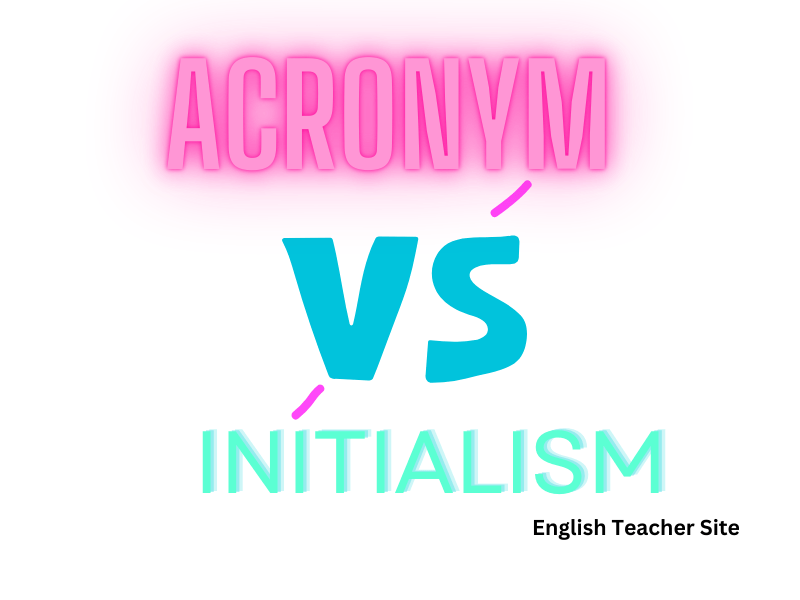What Are Acronyms: Understanding Abbreviated Language

- Acronyms are words formed by the initial letters of a phrase, pronounced as a single word.
- There is a distinct difference between acronyms and initialisms based on pronunciation.
- Shortenings are abbreviated forms of single words, unlike acronyms which represent phrases.
Acronyms are a staple in modern communication, often used to condense lengthy names or phrases into more manageable forms. They are created by taking the first letters of each word in the phrase and combining them into a new word that is pronounced as a single entity. For example, NASA stands for National Aeronautics and Space Administration, and it is universally recognized as a single word rather than a series of initials. The commonality and convenience of acronyms make them an integral component of daily language across various fields such as government, science, technology, and beyond.
Key Takeaways
- Acronyms are words formed by the initial letters of a phrase, pronounced as a single word.
- There is a distinct difference between acronyms and initialisms based on pronunciation.
- Shortenings are abbreviated forms of single words, unlike acronyms which represent phrases.
Decoding Acronyms
In the realm of written and spoken communication, acronyms serve as a compact means of conveying extensive phrases through their initials. Their prevalence spans across domains, from professional environments to digital messaging platforms.
Varieties of Abbreviations
Acronyms are often confused with other forms of abbreviations, yet they carry distinct characteristics. This subsection will outline the key forms of abbreviations in use.
Initialisms refer to abbreviations formed from the first letters of a series of words but are pronounced as separate letters. For example:
| Initialism | Full Phrase |
|---|---|
| FBI | Federal Bureau of Investigation |
| ASAP | As Soon As Possible |
Acronyms, unlike initialisms, are pronounced as words. They simplify communication and are frequently utilized in both casual and formal discourse. Here are a few common examples:
| Acronym | Full Phrase |
|---|---|
| NATO | North Atlantic Treaty Organization |
| Scuba | Self-Contained Underwater Breathing Apparatus |
In addition to these, there are blends, which mix parts of words rather than just their initial letters to create a new word. Examples include:
- Brunch (breakfast + lunch)
- Smog (smoke + fog)
Acronym vs. Initialism
In the realm of abbreviations, acronyms and initialisms are often used interchangeably, yet they represent different concepts. To understand their usage in the English language, recognizing the distinction between them is crucial. An acronym is a type of abbreviation formed from the initial letters of other words and pronounced as a word. On the other hand, an initialism is created from the first letters of a phrase but is uttered as a sequence of letters.
| Acronyms | Initialisms |
|---|---|
| NASA | FBI |
| Scuba | ATM |
| Radar | IRS |
| AIDS | DVD |
Examples of acronyms:
- NASA: National Aeronautics and Space Administration
- Scuba: Self-Contained Underwater Breathing Apparatus
Examples of initialisms:
- FBI: Federal Bureau of Investigation
- ATM: Automated Teller Machine
The key difference lies in how they are pronounced:
Acronyms (Pronunciation):
- NASA sounds like “nasa”
- Scuba sounds like “skooba”
Initialisms (Pronunciation):
- FBI sounds like “F-B-I”
- ATM sounds like “A-T-M”
The use of acronyms and initialisms is widespread. They simplify communication by shortening long phrases into manageable strings of letters. They are prevalent in formal and informal writing, seen in contexts ranging from scientific to military to everyday jargon. However, when using acronyms and initialisms, clarity is paramount to ensure that the abbreviation is familiar or well-explained to avoid confusion.
Acronym vs. Shortenings (or Truncations)
Acronyms are constructed from the initial letters of a series of words and are pronounced as one word, unlike truncations which are simply abbreviated forms of a single word.
Commonly Used Acronyms in English
Acronyms are prevalent in everyday communication, and their use spans various domains from government organizations to technological terms. Here is a table highlighting some commonly used acronyms:
| Acronym | Stands for |
|---|---|
| NASA | National Aeronautics and Space Administration |
| LASER | Light Amplification by Stimulated Emission of Radiation |
| RADAR | Radio Detection And Ranging |
| AIDS | Acquired Immune Deficiency Syndrome |
In addition to these, everyday conversation features acronyms that make communication more efficient. A few examples include:
- ASAP – As Soon As Possible
- PIN – Personal Identification Number
- DIY – Do It Yourself
Truncations, on the other hand, do not form new words but are abridged versions of longer words. Consider how we use “doc” instead of “document” or “math” instead of “mathematics.” Truncations often become words in their own right, accepted in everyday usage.
Understanding Initialisms
When delving into the English language’s various forms of abbreviation, one encounters initialisms — a subset distinct from acronyms. Initialisms are comprised of the first letter of each word in a phrase, which are then pronounced individually. An accessible method to differentiate them from acronyms is to consider their phonetic properties; initialisms are sounded out letter by letter, whereas acronyms form pronounceable words.
Initialisms are commonly employed for convenience and efficiency, particularly in written communication — to save space and time. They are pervasive in daily language and can be found in contexts ranging from government agencies to technology terms. For example, FBI stands for the Federal Bureau of Investigation, and CPU represents the Central Processing Unit in a computer.
To further exemplify initialisms, here are two tables summarizing their use in distinct fields:
Government Agencies
| Initialism | Full Form |
|---|---|
| FBI | Federal Bureau of Investigation |
| CIA | Central Intelligence Agency |
| EPA | Environmental Protection Agency |
Technology Terms
| Initialism | Full Form |
|---|---|
| CPU | Central Processing Unit |
| USB | Universal Serial Bus |
| HTML | HyperText Markup Language |
In addition to these, initialisms are frequently used in less formal exchanges, such as text messaging, where abbreviations like BRB (Be Right Back) and OMG (Oh My God) dominate.
It’s essential to note that while certain initialisms may begin to be pronounced as words, they are not considered acronyms until the shift in pronunciation is widely accepted. A prime example of this is NASA, which started as an initialism but is now a universally recognized acronym.
Source
1. “Types of abbreviations”, https://www.crownacademyenglish.com/types-english-abbreviations
My name is Khamis Maiouf. I am the creator of the English Teacher Site, dedicated to providing valuable resources and insights for students around the world. With a passion for education and a commitment to helping students enhance their skills, I aim to make English teaching more effective and enjoyable for both educators and students.






